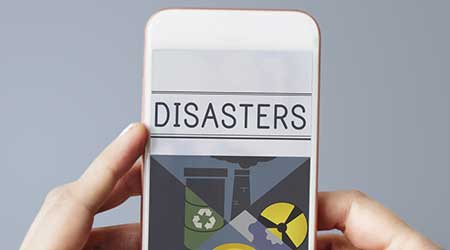5 Technologies Driving Future Mass Notification Developments
Five fundamental technologies that will drive future developments are all available today, some in very advanced stages.
1. Cloud-based software: Cloud services will underlie many of the successful outcomes listed above. Instead of data and algorithms existing separately on a facility’s local computer network where they are isolated and vulnerable to data loss and outdatedness, they exist in the cloud where they can be verified, updated, and leveraged in combination with additional software as necessary. The cloud enables software-as-a-service so third-party solutions can be implemented. An example is in the multilanguage example above — instead of facilities each installing their own language translation software, they can pay a fee that allows their system to send text to a cloud-based translation service, which sends it back translated in the language requested by each user. Cloud services also enable the use of subscription services that facilitate two-way communication, and user profiles which allow custom actions such as notifying friends, family, and workplaces when emergencies occur.
2. Internet of Things: IoT allows individual appliances and pieces of equipment to self-monitor and communicate their data through the cloud to other appliances, equipment, and software services. The wheelchair in the special needs description above is a basic example, but when properly equipped, any self-contained item such as elevators, doors and other physical objects can communicate vital data on a facility’s occupancy, the viability of access and egress routes, an area’s temperature levels, human activity, and much more.
3. Geographic information systems: In addition to pinpointing the location of geographic information system (GIS)-equipped devices (and therefore users), GIS protocols such as geofencing offer the ability to track entrance to and exit from GIS-based perimeters or zones. With this information, the mass notification system can do things like notify drivers when they are approaching restricted areas, bridge or road closures, or hazardous conditions like icy roads. In the context-aware example above, a text alert regarding the water spill and the recommended exits wasn’t sent until it was clear the information was pertinent to the user. Those for whom the information wasn’t currently necessary weren’t disturbed. Geofencing also played a role in the example where multiple language options were offered within an area known for hosting foreign visitors.
4. Artificial intelligence: Artificial intelligence (AI) is currently a primary focus of most major tech companies. Automatic translation, voice recognition, and situational analysis are all achieving high levels of accuracy using AI engines, and they will continue to improve. Precious minutes can be saved in emergency situations when decisions can be accurately made without requiring human input. This is an area where careful attention to the appropriate integration of human workflows and protocols are vital.
5. Data aggregation and analytics: The powerful analytical processes that can be applied to data will most often be applied during non-emergency situations. Data acquired from sensors, IoT, users, and post-event reports can be crunched to refine best practices for all aspects of mass notification systems, improving them on a continuous basis.
It’s a common aspect of emerging technologies that the very qualities that make them attractive and potent also make them troubling. Taking advantage of the potential of these technologies in many cases requires a mobile device — not everyone has one, and even if they do, batteries run down and there are privacy concerns (you must give up a lot of personal information to gain the benefits). Cybersecurity is also a critical issue — mass notification is an inherently powerful tool, so it can be powerfully exploited by those interested in causing harm. A system’s vulnerability increases with its versatility.
Many of the time-tested, accessible elements of current systems, such as audial and visual alarms, will stay in use for a while because they meet mandatory IFC and IBC codes and are designed for the lowest common denominator of mass notification. They’ve saved countless lives. But there are great opportunities for both business and public safety that lie beyond the mandatory codes. In addition to the codes and NFPA 72, attention must be paid to both new technologies and their associated market forces. There is positive disruption underway, and the mass notification systems field’s professional organizations, publications, and consulting services are becoming more important than ever, because with options comes complexity.
But with a broad view, a clear focus, and strong collaboration, playing a part in ensuring that in any emergency everyone emerges safe and sound will no longer be in the future. It will be now.
Isaac Chen is a vice president at WSP, one of the world’s leading engineering and professional services firms, with over 25 years of experience in software development and electrical and telecommunication engineering. His expertise includes the design and management of the acquisition and implementation of programs for a variety of project types.
Victoria Childs is a senior technology engineer at WSP, with nearly 30 years of experience in fire alarm, communications, and security engineering experience.
The authors can be reached at usinfo@wsp.com.
Related Topics:














